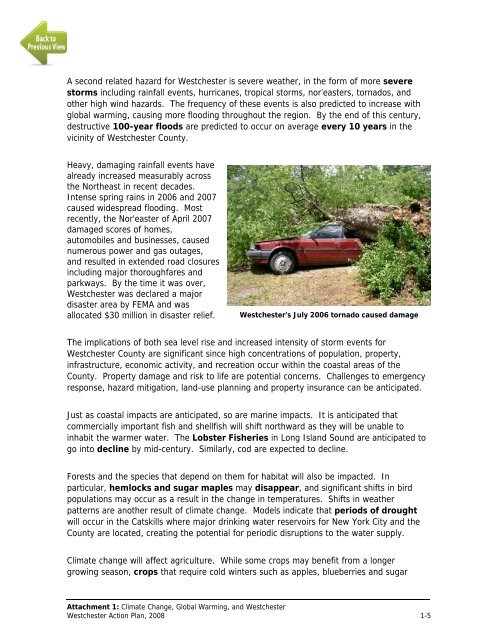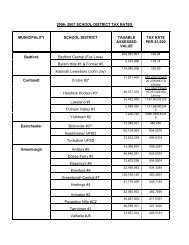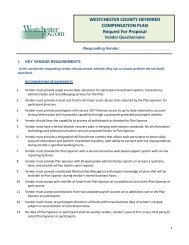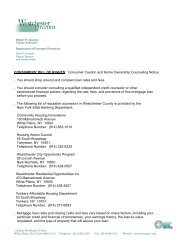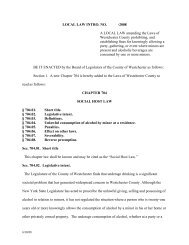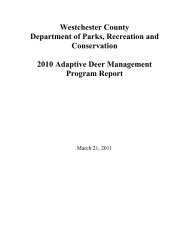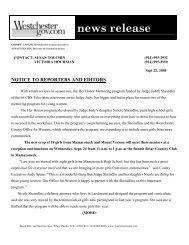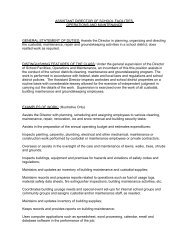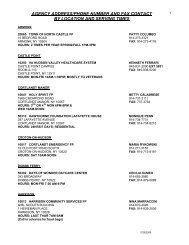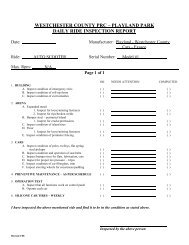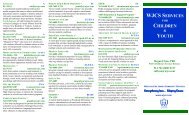Westchester Action Plan, 2008 - Westchester County Government
Westchester Action Plan, 2008 - Westchester County Government
Westchester Action Plan, 2008 - Westchester County Government
Create successful ePaper yourself
Turn your PDF publications into a flip-book with our unique Google optimized e-Paper software.
A second related hazard for <strong>Westchester</strong> is severe weather, in the form of more severe<br />
storms including rainfall events, hurricanes, tropical storms, nor’easters, tornados, and<br />
other high wind hazards. The frequency of these events is also predicted to increase with<br />
global warming, causing more flooding throughout the region. By the end of this century,<br />
destructive 100-year floods are predicted to occur on average every 10 years in the<br />
vicinity of <strong>Westchester</strong> <strong>County</strong>.<br />
Heavy, damaging rainfall events have<br />
already increased measurably across<br />
the Northeast in recent decades.<br />
Intense spring rains in 2006 and 2007<br />
caused widespread flooding. Most<br />
recently, the Nor'easter of April 2007<br />
damaged scores of homes,<br />
automobiles and businesses, caused<br />
numerous power and gas outages,<br />
and resulted in extended road closures<br />
including major thoroughfares and<br />
parkways. By the time it was over,<br />
<strong>Westchester</strong> was declared a major<br />
disaster area by FEMA and was<br />
allocated $30 million in disaster relief.<br />
<strong>Westchester</strong>’s July 2006 tornado caused damage<br />
The implications of both sea level rise and increased intensity of storm events for<br />
<strong>Westchester</strong> <strong>County</strong> are significant since high concentrations of population, property,<br />
infrastructure, economic activity, and recreation occur within the coastal areas of the<br />
<strong>County</strong>. Property damage and risk to life are potential concerns. Challenges to emergency<br />
response, hazard mitigation, land-use planning and property insurance can be anticipated.<br />
Just as coastal impacts are anticipated, so are marine impacts. It is anticipated that<br />
commercially important fish and shellfish will shift northward as they will be unable to<br />
inhabit the warmer water. The Lobster Fisheries in Long Island Sound are anticipated to<br />
go into decline by mid-century. Similarly, cod are expected to decline.<br />
Forests and the species that depend on them for habitat will also be impacted. In<br />
particular, hemlocks and sugar maples may disappear, and significant shifts in bird<br />
populations may occur as a result in the change in temperatures. Shifts in weather<br />
patterns are another result of climate change. Models indicate that periods of drought<br />
will occur in the Catskills where major drinking water reservoirs for New York City and the<br />
<strong>County</strong> are located, creating the potential for periodic disruptions to the water supply.<br />
Climate change will affect agriculture. While some crops may benefit from a longer<br />
growing season, crops that require cold winters such as apples, blueberries and sugar<br />
Attachment 1: Climate Change, Global Warming, and <strong>Westchester</strong><br />
<strong>Westchester</strong> <strong>Action</strong> <strong>Plan</strong>, <strong>2008</strong> 1-5


